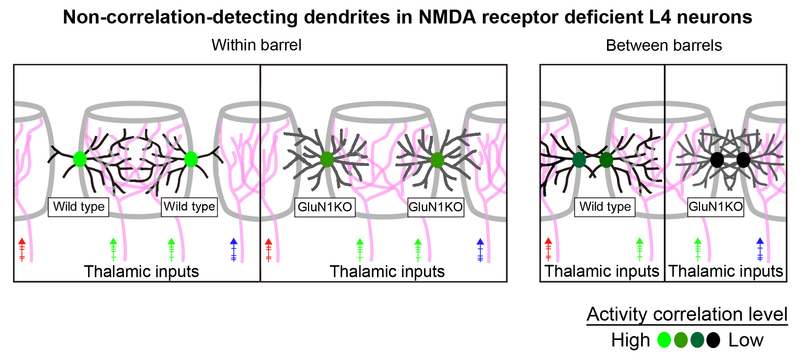- HOME
- News & Events
- Publications
- 【Publications】NMDA Receptor Enhances Correlation of Spontaneous Activity in Neonatal Barrel Cortex
Publications
【Publications】NMDA Receptor Enhances Correlation of Spontaneous Activity in Neonatal Barrel Cortex
January 19 2021
Hidenobu MIZUNO
Paper information
Mizuno H*(*Corresponding author), Rao MS, Mizuno H, Sato T, Nakazawa S, Iwasato T
NMDA Receptor Enhances Correlation of Spontaneous Activity in Neonatal Barrel Cortex
The Journal of Neuroscience 28 December 2020, JN-RM-0527-20; DOI: 10.1523/JNEUROSCI.0527-20.2020
Abstract
Correlated spontaneous activity plays critical role in the organization of neocortical circuits during development. However, cortical mechanisms regulating activity correlation are still elusive. In this study, using two-photon calcium imaging of the barrel cortex layer 4 (L4) in living neonatal mice, we found that N-methyl-D-aspartate (NMDA) receptors (NMDARs) in L4 neurons are important for enhancement of spontaneous activity correlation. Disruption of GluN1 (Grin1), an obligatory NMDAR subunit, in a sparse population of L4 neurons reduced activity correlation between GluN1 knockout (GluN1KO) neuron pairs within a barrel. This reduction in activity correlation was even detected in L4 neuron pairs in neighboring barrels, and most evident when either or both of neurons are located on the barrel edge. Our results provide evidence for the involvement of L4 neuron NMDARs in spatial organization of the spontaneous firing activity of L4 neurons in the neonatal barrel cortex.
Significance Statement
Precise wiring of the thalamocortical circuits is necessary for proper sensory information processing, and thalamus-derived correlated spontaneous activity is important for thalamocortical circuit formation. The molecular mechanisms involved in the correlated activity transfer from the thalamus to the neocortex are largely unknown. In vivo two-photon calcium imaging of the neonatal barrel cortex revealed that correlated spontaneous activity between layer 4 neurons is reduced by mosaic knockout of the NMDAR obligatory subunit GluN1. Our results suggest that the function of NMDARs in layer 4 neurons is necessary for the communication between presynaptic and postsynaptic partners during thalamocortical circuit formation

